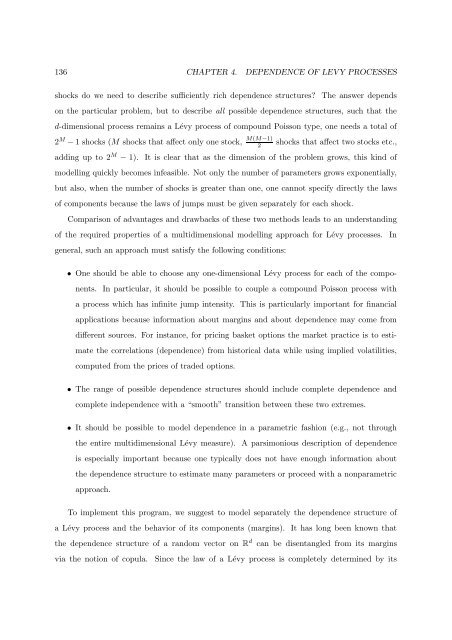Processus de Lévy en Finance - Laboratoire de Probabilités et ...
Processus de Lévy en Finance - Laboratoire de Probabilités et ...
Processus de Lévy en Finance - Laboratoire de Probabilités et ...
Create successful ePaper yourself
Turn your PDF publications into a flip-book with our unique Google optimized e-Paper software.
136 CHAPTER 4. DEPENDENCE OF LEVY PROCESSES<br />
shocks do we need to <strong>de</strong>scribe suffici<strong>en</strong>tly rich <strong>de</strong>p<strong>en</strong><strong>de</strong>nce structures? The answer <strong>de</strong>p<strong>en</strong>ds<br />
on the particular problem, but to <strong>de</strong>scribe all possible <strong>de</strong>p<strong>en</strong><strong>de</strong>nce structures, such that the<br />
d-dim<strong>en</strong>sional process remains a Lévy process of compound Poisson type, one needs a total of<br />
2 M − 1 shocks (M shocks that affect only one stock, M(M−1)<br />
2<br />
shocks that affect two stocks <strong>et</strong>c.,<br />
adding up to 2 M − 1). It is clear that as the dim<strong>en</strong>sion of the problem grows, this kind of<br />
mo<strong>de</strong>lling quickly becomes infeasible. Not only the number of param<strong>et</strong>ers grows expon<strong>en</strong>tially,<br />
but also, wh<strong>en</strong> the number of shocks is greater than one, one cannot specify directly the laws<br />
of compon<strong>en</strong>ts because the laws of jumps must be giv<strong>en</strong> separately for each shock.<br />
Comparison of advantages and drawbacks of these two m<strong>et</strong>hods leads to an un<strong>de</strong>rstanding<br />
of the required properties of a multidim<strong>en</strong>sional mo<strong>de</strong>lling approach for Lévy processes.<br />
g<strong>en</strong>eral, such an approach must satisfy the following conditions:<br />
• One should be able to choose any one-dim<strong>en</strong>sional Lévy process for each of the compon<strong>en</strong>ts.<br />
In particular, it should be possible to couple a compound Poisson process with<br />
a process which has infinite jump int<strong>en</strong>sity. This is particularly important for financial<br />
applications because information about margins and about <strong>de</strong>p<strong>en</strong><strong>de</strong>nce may come from<br />
differ<strong>en</strong>t sources. For instance, for pricing bask<strong>et</strong> options the mark<strong>et</strong> practice is to estimate<br />
the correlations (<strong>de</strong>p<strong>en</strong><strong>de</strong>nce) from historical data while using implied volatilities,<br />
computed from the prices of tra<strong>de</strong>d options.<br />
In<br />
• The range of possible <strong>de</strong>p<strong>en</strong><strong>de</strong>nce structures should inclu<strong>de</strong> compl<strong>et</strong>e <strong>de</strong>p<strong>en</strong><strong>de</strong>nce and<br />
compl<strong>et</strong>e in<strong>de</strong>p<strong>en</strong><strong>de</strong>nce with a “smooth” transition b<strong>et</strong>we<strong>en</strong> these two extremes.<br />
• It should be possible to mo<strong>de</strong>l <strong>de</strong>p<strong>en</strong><strong>de</strong>nce in a param<strong>et</strong>ric fashion (e.g., not through<br />
the <strong>en</strong>tire multidim<strong>en</strong>sional Lévy measure). A parsimonious <strong>de</strong>scription of <strong>de</strong>p<strong>en</strong><strong>de</strong>nce<br />
is especially important because one typically does not have <strong>en</strong>ough information about<br />
the <strong>de</strong>p<strong>en</strong><strong>de</strong>nce structure to estimate many param<strong>et</strong>ers or proceed with a nonparam<strong>et</strong>ric<br />
approach.<br />
To implem<strong>en</strong>t this program, we suggest to mo<strong>de</strong>l separately the <strong>de</strong>p<strong>en</strong><strong>de</strong>nce structure of<br />
a Lévy process and the behavior of its compon<strong>en</strong>ts (margins). It has long be<strong>en</strong> known that<br />
the <strong>de</strong>p<strong>en</strong><strong>de</strong>nce structure of a random vector on R d can be dis<strong>en</strong>tangled from its margins<br />
via the notion of copula.<br />
Since the law of a Lévy process is compl<strong>et</strong>ely <strong>de</strong>termined by its
















